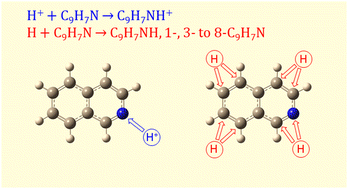Infrared spectra of isoquinolinium (iso-C9H7NH+) and isoquinolinyl radicals (iso-C9H7NH and 1-, 3-, 4-, 5-, 6-, 7- and 8-iso-HC9H7N) isolated in solid para-hydrogen†
Abstract
Protonated polycyclic aromatic nitrogen heterocycles (H+PANH) are prospective candidates that may contribute to interstellar unidentified infrared (UIR) emission bands because protonation enhances the relative intensities of the bands near 6.2, 7.7 and 8.6 μm, and the presence of the N atom induces a blue shift of the ring-stretching modes so that the spectra of H+PANH match better with the 6.2 μm feature in class-A UIR spectra. We report the infrared (IR) spectra of protonated isoquinoline (the 2-isoquinolinium cation, iso-C9H7NH+), its neutral counterpart (the 2-isoquinolinyl radical, iso-C9H7NH), and another mono-hydrogenated product (the 6-isoquinolinyl radical, 6-iso-HC9H7N), produced on the electron-bombardment of a mixture of isoquinoline (iso-C9H7N) with excess para-hydrogen (p-H2) during matrix deposition at 3.2 K. To generate additional isomers of hydrogenated isoquinoline, we irradiated iso-C9H7N/Cl2/p-H2 matrices at 365 nm to generate Cl atoms, followed by IR irradiation to generate H atoms via Cl + H2 (v = 1) → HCl + H; the H atoms thus generated reacted with iso-C9H7N. In addition to iso-C9H7NH and 6-iso-HC9H7N observed in the electron-bombardment experiments, we identified six additional hydrogenated isoquinoline species, 1-, 3-, 4-, 5-, 7- and 8-iso-HC9H7N, via their IR spectra; hydrogenation on the N atom and all available carbon atoms except for the two sharing carbon atoms on the fused ring was observed. Spectral groupings were achieved according to their behaviors after maintenance of the matrix in darkness and on secondary photolysis at various wavelengths. The assignments were supported via comparison of the experimental results with the vibrational wavenumbers and IR intensities of possible isomers predicted using the B3LYP/6-311++G(d,p) method. The implications in the identification of the UIR band are discussed.

- This article is part of the themed collection: 2023 PCCP HOT Articles


 Please wait while we load your content...
Please wait while we load your content...